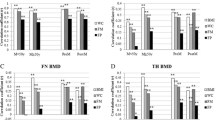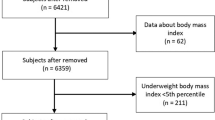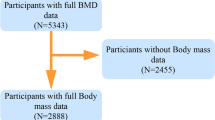Abstract
This study aimed to assess the associations of total body fat and fat distribution with bone mineral density (BMD) among children and adolescents in this cross-sectional study. A total of 1032 boys and 897 girls aged 6–17 years were enrolled between May 2019 and June 2019 in Guangzhou, China. BMD, total body fat (fat mass index [FMI] and body fat percentage [BF%]), and fat distribution (trunk-to-limb and android-to-gynoid ratios) were measured by dual-energy X-ray absorptiometry. Inverse probability of treatment weighting regression was used to explore the association between fat and BMD. Traditional regression of covariate adjustment was applied as sensitivity analysis. Regression with inverse probability weighting suggested BF% and android-to-gynoid ratio were negatively associated with BMD in boys (β = − 0.12 and − 0.16, respectively; P < 0.05). Android-to-gynoid ratio was also inversely associated with BMD in girls (β = − 0.08, P < 0.05). When stratified by age, the negative associations were retained in boys aged 12–17 years (β = − 0.23 and − 0.25, respectively; P < 0.001). But for girls, it showed a positive association of FMI with BMD in the 6–9 years group (β = 0.33, P < 0.001) and a negative association between the android-to-gynoid ratio and BMD in the 10–17 years group (β = − 0.10, P < 0.05). Traditional regression supported the robustness of the results.
Conclusion: Total body fat is positively associated with BMD in younger girls but inversely associated in older boys. As for abdominal adipose, it is associated with lower BMD in both older boys and girls.
What is Known: • The lean mass has been consistently positively associated with bone mineral density (BMD) among children and adolescents. However, the impact of fat mass on BMD remained controversial. • Beyond total body fat, site-specific fat mass, especially abdominal adiposity, might impede bone formation. | |
What is New: • The associations of total body fat and fat distribution with BMD in children and adolescents were gender- and age-specific. • More attention should be paid to the abdominal fat accumulation to promote bone health in older children. |





Similar content being viewed by others
Availability of data
The datasets used or analyzed during the current study are available from the corresponding author on reasonable request.
Abbreviations
- A/G ratio:
-
Android-to-gynoid fat ratio
- BF%:
-
Body fat percentage
- BMD:
-
Bone mineral density
- DXA:
-
Dual-energy X-ray absorptiometry
- FM:
-
Fat mass
- FMI:
-
Fat mass index
- GPS:
-
Generalized propensity score
- IPTW:
-
Inverse probability of treatment weighting
- LM:
-
Lean mass
- TBLH BMD:
-
Total body less head bone mineral density
- T/L ratio:
-
Trunk-to-limb fat ratio
References
Shilian H, Jing W, Cui C, Xinchun W (2020) Analysis of epidemiological trends in chronic diseases of Chinese residents. Aging Med (Milton) 3(4):226–233. https://doi.org/10.1002/agm2.12134
(1991) Consensus development conference: prophylaxis and treatment of osteoporosis. Am J Med 90(1):107–110.https://doi.org/10.1016/0002-9343(93)90218-e
Gordon CM, Zemel BS, Wren TA, Leonard MB, Bachrach LK, Rauch F, Gilsanz V, Rosen CJ, Winer KK (2017) The determinants of peak bone mass. J Pediatr 180:261–269. https://doi.org/10.1016/j.jpeds.2016.09.056
Gordon RJ, Gordon CM (2020) Adolescents and bone health. Clin Obstet Gynecol 63(3):504–511. https://doi.org/10.1097/Grf.0000000000000548
Mosca LN, da Silva VN, Goldberg TB (2013) Does excess weight interfere with bone mass accumulation during adolescence? Nutrients 5(6):2047–2061. https://doi.org/10.3390/nu5062047
Sioen I, Lust E, De Henauw S, Moreno LA, Jimenez-Pavon D (2016) Associations between body composition and bone health in children and adolescents: a systematic review. Calcif Tissue Int 99(6):557–577. https://doi.org/10.1007/s00223-016-0183-x
Ho-Pham LT, Nguyen UD, Nguyen TV (2014) Association between lean mass, fat mass, and bone mineral density: a meta-analysis. J Clin Endocrinol Metab 99(1):30–38. https://doi.org/10.1210/jc.2013-3190
Reid IR (2010) Fat and bone. Arch Biochem Biophys 503(1):20–27. https://doi.org/10.1016/j.abb.2010.06.027
Dolan E, Swinton PA, Sale C, Healy A, O’Reilly J (2017) Influence of adipose tissue mass on bone mass in an overweight or obese population: systematic review and meta-analysis. Nutr Rev 75(10):858–870. https://doi.org/10.1093/nutrit/nux046
Maggio AB, Belli DC, Puigdefabregas JW, Rizzoli R, Farpour-Lambert NJ, Beghetti M, McLin VA (2014) High bone density in adolescents with obesity is related to fat mass and serum leptin concentrations. J Pediatr Gastroenterol Nutr 58(6):723–728. https://doi.org/10.1097/MPG.0000000000000297
Heidemann M, Holst R, Schou AJ, Klakk H, Husby S, Wedderkopp N, Molgaard C (2015) The influence of anthropometry and body composition on children’s bone health: the childhood health, activity and motor performance school (the CHAMPS) study. Denmark Calcif Tissue Int 96(2):97–104. https://doi.org/10.1007/s00223-014-9941-9
Clark EM, Ness AR, Tobias JH (2006) Adipose tissue stimulates bone growth in prepubertal children. J Clin Endocrinol Metab 91(7):2534–2541. https://doi.org/10.1210/jc.2006-0332
Janicka A, Wren TA, Sanchez MM, Dorey F, Kim PS, Mittelman SD, Gilsanz V (2007) Fat mass is not beneficial to bone in adolescents and young adults. J Clin Endocrinol Metab 92(1):143–147. https://doi.org/10.1210/jc.2006-0794
Liang J, Chen Y, Zhang J, Ma B, Hu Y, Liu Y, Lin S, Zhang Z, Song Y (2020) Associations of weight-adjusted body fat and fat distribution with bone mineral density in Chinese children aged 6–10 years. Int J Environ Res Public Health 17(5):1763. https://doi.org/10.3390/ijerph17051763
Rocher E, Chappard C, Jaffre C, Benhamou CL, Courteix D (2008) Bone mineral density in prepubertal obese and control children: relation to body weight, lean mass, and fat mass. J Bone Miner Metab 26(1):73–78. https://doi.org/10.1007/s00774-007-0786-4
Gallego Suarez C, Singer BH, Gebremariam A, Lee JM, Singer K (2017) The relationship between adiposity and bone density in U.S. children and adolescents. PLoS ONE 12(7):e0181587. https://doi.org/10.1371/journal.pone.0181587
Gracia-Marco L, Ortega FB, Jimenez-Pavon D, Rodriguez G, Castillo MJ, Vicente-Rodriguez G, Moreno LA (2012) Adiposity and bone health in Spanish adolescents. The HELENA study. Osteoporos Int 23(3):937–947. https://doi.org/10.1007/s00198-011-1649-3
Russell M, Mendes N, Miller KK, Rosen CJ, Lee H, Klibanski A, Misra M (2010) Visceral fat is a negative predictor of bone density measures in obese adolescent girls. J Clin Endocrinol Metab 95(3):1247–1255. https://doi.org/10.1210/jc.2009-1475
Rokoff LB, Rifas-Shiman SL, Switkowski KM, Young JG, Rosen CJ, Oken E, Fleisch AF (2019) Body composition and bone mineral density in childhood. Bone 121(2019):9–15. https://doi.org/10.1016/j.bone.2018.12.009
Pollock NK, Bernard PJ, Gutin B, Davis CL, Zhu H, Dong Y (2011) Adolescent obesity, bone mass, and cardiometabolic risk factors. J Pediatr 158(5):727–734. https://doi.org/10.1016/j.jpeds.2010.11.052
Warming L, Ravn P, Christiansen C (2003) Visceral fat is more important than peripheral fat for endometrial thickness and bone mass in healthy postmenopausal women. Am J Obstet Gynecol 188(2):349–353. https://doi.org/10.1067/mob.2003.93
Loomba-Albrecht LA, Styne DM (2009) Effect of puberty on body composition. Curr Opin Endocrinol Diabetes Obes 16(1):10–15. https://doi.org/10.1097/med.0b013e328320d54c
Manolagas SC, O’Brien CA, Almeida M (2013) The role of estrogen and androgen receptors in bone health and disease. Nat Rev Endocrinol 9(12):699–712. https://doi.org/10.1038/nrendo.2013.179
Gordon CM, Bachrach LK, Carpenter TO, Crabtree N, El-Hajj Fuleihan G, Kutilek S, Lorenc RS, Tosi LL, Ward KA, Ward LM et al (2008) Dual energy X-ray absorptiometry interpretation and reporting in children and adolescents: the 2007 ISCD Pediatric Official Positions. J Clin Densitom 11(1):43–58. https://doi.org/10.1016/j.jocd.2007.12.005
Mosca LN, Goldberg TB, da Silva VN, da Silva CC, Kurokawa CS, Bisi Rizzo AC, Corrente JE (2014) Excess body fat negatively affects bone mass in adolescents. Nutrition 30(7–8):847–852. https://doi.org/10.1016/j.nut.2013.12.003
Júnior IFF, Cardoso JR, Christofaro DGD, Codogno JS, de Moraes ACF, Fernandes RA (2013) The relationship between visceral fat thickness and bone mineral density in sedentary obese children and adolescents. BMC Pediatr 13:37. https://doi.org/10.1186/1471-2431-13-37
Dong H, Yan Y, Liu J, Cheng H, Zhao X, Shan X, Huang G, Mi J, China Child and Adolescent Cardiovascular Health (CCACH) collaboration members (2021) Reference centiles for evaluating total body fat development and fat distribution by dual-energy x-ray absorptiometry among children and adolescents aged 3–18 years. Clin Nutr 40(3):1289–1295. https://doi.org/10.1016/j.clnu.2020.08.012
Liu J, Wang L, Sun J, Liu G, Yan W, Xi B, Xiong F, Ding W, Huang G, Heymsfield S et al (2017) Bone mineral density reference standards for Chinese children aged 3–18: cross-sectional results of the 2013–2015 China Child and Adolescent Cardiovascular Health (CCACH) Study. BMJ Open 7(5):e014542. https://doi.org/10.1136/bmjopen-2016-014542
Liu J, Yan Y, Xi B, Huang G, Mi J, China Child and Adolescent Cardiovascular Health (CCACH) Study Group (2019) Skeletal muscle reference for Chinese children and adolescents. J Cachexia Sarcopenia Muscle 10(1):155–164. https://doi.org/10.1002/jcsm.12361
Austin PC, Stuart EA (2015) Moving towards best practice when using inverse probability of treatment weighting (IPTW) using the propensity score to estimate causal treatment effects in observational studies. Stat Med 34(28):3661–3679. https://doi.org/10.1002/sim.6607
Zhu Y, Coffman DL, Ghosh D (2015) A boosting algorithm for estimating generalized propensity scores with continuous treatments. J Causal Inference 3(1):25–40. https://doi.org/10.1515/jci-2014-0022
Ao L (2020) Analysis for the effect of genetic variants in vitamin D metabolism pathway on vitamin D level and bone mass development in children and adolescents. Dissertation, Guangdong Pharmaceutical University
Weaver B, Wuensch KL (2013) SPSS and SAS programs for comparing Pearson correlations and OLS regression coefficients. Behav Res Methods 45(3):880–895. https://doi.org/10.3758/s13428-012-0289-7
Douchi T, Kuwahata R, Matsuo T, Uto H, Oki T, Nagata Y (2003) Relative contribution of lean and fat mass component to bone mineral density in males. J Bone Miner Metab 21(1):17–21. https://doi.org/10.1007/s007740300003
Liu JM, Zhao HY, Ning G, Zhao YJ, Zhang LZ, Sun LH, Xu MY, Chen JL (2004) Relationship between body composition and bone mineral density in healthy young and premenopausal Chinese women. Osteoporos Int 15(3):238–242. https://doi.org/10.1007/s00198-003-1536-7
Abbas MA (2017) Physiological functions of Vitamin D in adipose tissue. J Steroid Biochem Mol Biol 165(Pt B):369–381. https://doi.org/10.1016/j.jsbmb.2016.08.004
Barja-Fernandez S, Aguilera CM, Martinez-Silva I, Vazquez R, Gil-Campos M, Olza J, Bedoya J, Cadarso-Suarez C, Gil A, Seoane LM et al (2018) 25-Hydroxyvitamin D levels of children are inversely related to adiposity assessed by body mass index. J Physiol Biochem 74(1):111–118. https://doi.org/10.1007/s13105-017-0581-1
Syed F, Khosla S (2005) Mechanisms of sex steroid effects on bone. Biochem Biophys Res Commun 328(3):688–696. https://doi.org/10.1016/j.bbrc.2004.11.097
Ahn SH, Lee SH, Kim H, Kim BJ, Koh JM (2014) Different relationships between body compositions and bone mineral density according to gender and age in Korean populations (KNHANES 2008–2010). J Clin Endocrinol Metab 99(10):3811–3820. https://doi.org/10.1210/jc.2014-1564
Koziel S, Malina RM (2005) Variation in relative fat distribution associated with maturational timing: the wroclaw growth study. Ann Hum Biol 32(6):691–701. https://doi.org/10.1080/03014460500268531
Cao JJ (2011) Effects of obesity on bone metabolism. J Orthop Surg Res 6:30. https://doi.org/10.1186/1749-799X-6-30
Abraham TM, Pedley A, Massaro JM, Hoffmann U, Fox CS (2015) Association between visceral and subcutaneous adipose depots and incident cardiovascular disease risk factors. Circulation 132(17):1639–1647. https://doi.org/10.1161/CIRCULATIONAHA.114.015000
Gilsanz V, Chalfant J, Mo AO, Lee DC, Dorey FJ, Mittelman SD (2009) Reciprocal relations of subcutaneous and visceral fat to bone structure and strength. J Clin Endocrinol Metab 94(9):3387–3393. https://doi.org/10.1210/jc.2008-2422
Pal China S, Sanyal S, Chattopadhyay N (2018) Adiponectin signaling and its role in bone metabolism. Cytokine 112:116–131. https://doi.org/10.1016/j.cyto.2018.06.012
Glass NA, Torner JC, Letuchy EM, Burns TL, Janz KF, Eichenberger Gilmore JM, Schlechte JA, Levy SM (2018) Does visceral or subcutaneous fat influence peripheral cortical bone strength during adolescence? A longitudinal study. J Bone Miner Res 33(4):580–588. https://doi.org/10.1002/jbmr.3325
Chrzanowska M, Suder A (2008) Ontogenesis changes and sex dimorphism of subcutaneous fat distribution: 12-year longitudinal study of children and adolescents from Cracow, Poland. Am J Hum Biol 20(4):424–430. https://doi.org/10.1002/ajhb.20749
Rosenbaum PR, Rubin DB (1984) Reducing bias in observational studies using subclassification on the propensity score. J Am Stat Assoc 79(387):516–524. https://doi.org/10.1080/01621459.1984.10478078
Kröger H, Kotaniemi A, Kröger L, Alhava E (1993) Development of bone mass and bone density of the spine and femoral neck–a prospective study of 65 children and adolescents. Bone Miner 23(3):171–182. https://doi.org/10.1016/s0169-6009(08)80094-3
Shaw N, Crabtree N (2019) Bone density in children: what are we measuring? Arch Dis Child 104(11):1108–1111. https://doi.org/10.1136/archdischild-2019-316940
Acknowledgements
We thank all funders of the presented study listed in the funding section as well as all children for their participation in this study and the study team for data collection and processing.
Funding
This work was supported by the National Natural Science Foundation of China (Grant 81874271; 81973110) and by the Science and Technology Innovation Strategy Special Fund of Guangdong Province (Grant pdjh2021a0258).
Author information
Authors and Affiliations
Contributions
Conceptualization, Wanwen Yao, Liping Ao, Hong Cheng, Shuang Lu, Yi Yang, and Li Liu; data curation, Li Liu; formal analysis, Wanwen Yao; funding acquisition, Jie Mi and Li Liu; investigation, Wanwen Yao, Liping Ao, and Shuang Lu; methodology, Wanwen Yao and Jiepeng Luo; project administration, Li Liu; resources, Jie Mi, Yi Yang, and Li Liu; supervision, Hong Cheng, Junting Liu, Jie Mi, Yi Yang, and Li Liu; visualization, Wanwen Yao; writing—original draft, Wanwen Yao; writing— review & editing, Jiepeng Luo, Liping Ao, Hong Cheng, Shuang Lu, Junting Liu, Keyuan Lu, Jie Mi, Yi Yang, and Li Liu.
Corresponding authors
Ethics declarations
Ethics approval
This study was approved by the Ethics Review Boards of Guangdong Pharmaceutical University (Med Ref No. 2018–27).
Consent to participate
Written informed consent was obtained from parents or legal guardians for each participant.
Consent for publication
Not applicable.
Competing interests
The authors declare no competing interests.
Additional information
Communicated by Gregorio Milani.
Publisher's Note
Springer Nature remains neutral with regard to jurisdictional claims in published maps and institutional affiliations.
Supplementary Information
Below is the link to the electronic supplementary material.
Rights and permissions
Springer Nature or its licensor (e.g. a society or other partner) holds exclusive rights to this article under a publishing agreement with the author(s) or other rightsholder(s); author self-archiving of the accepted manuscript version of this article is solely governed by the terms of such publishing agreement and applicable law.
About this article
Cite this article
Yao, W., Luo, J., Ao, L. et al. Association of total body fat and fat distribution with bone mineral density among children and adolescents aged 6–17 years from Guangzhou, China. Eur J Pediatr 182, 1115–1126 (2023). https://doi.org/10.1007/s00431-022-04727-x
Received:
Revised:
Accepted:
Published:
Issue Date:
DOI: https://doi.org/10.1007/s00431-022-04727-x




